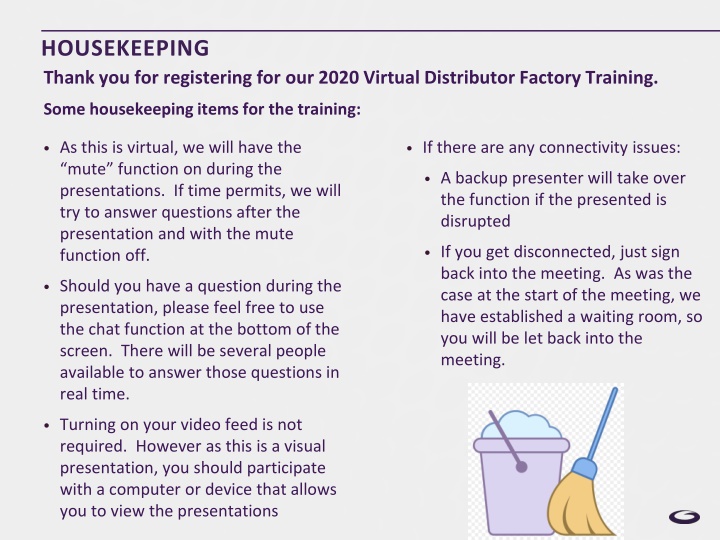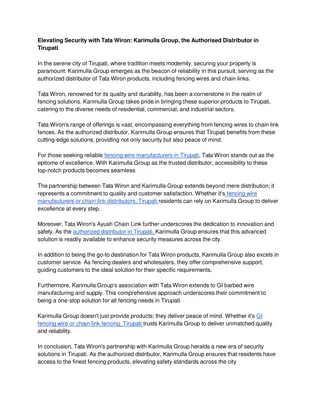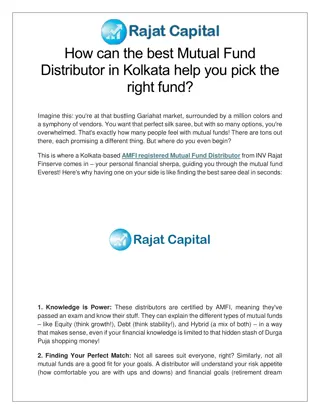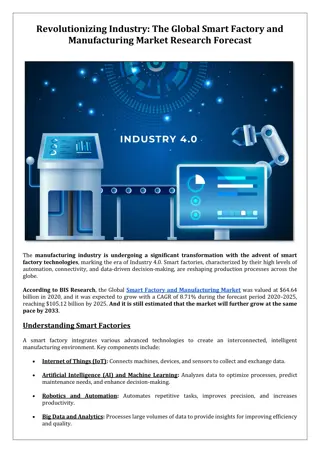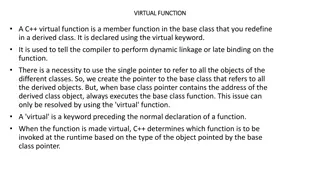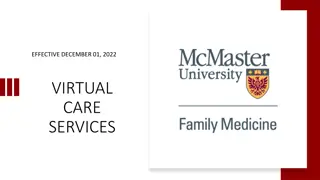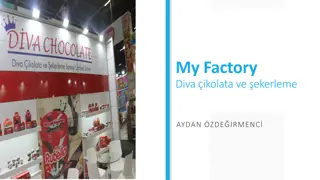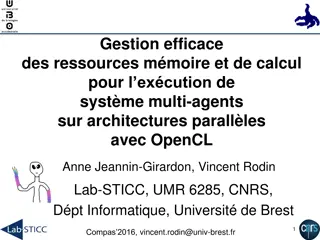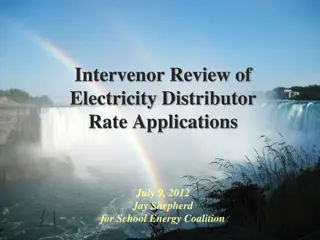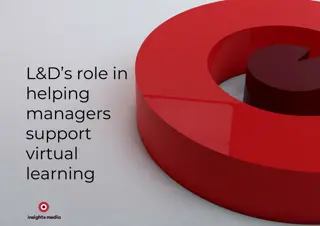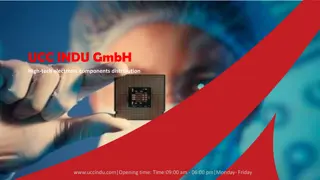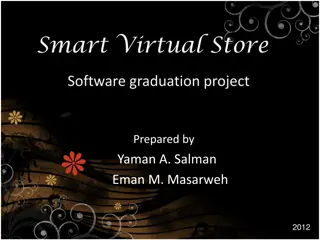Virtual Distributor Factory Training 2020 Overview
Join the 2020 Virtual Distributor Factory Training for insights on filtration basics, unit of measure, Graver LPF product range, dead-end filtration, and the importance of liquid filtration. Stay engaged during the virtual training sessions with key details and visuals provided. Learn about different filtration technologies, particle capture mechanisms, and why liquid filtration is essential. Make the most of this educational opportunity to enhance your understanding of industrial filtration processes.
Download Presentation

Please find below an Image/Link to download the presentation.
The content on the website is provided AS IS for your information and personal use only. It may not be sold, licensed, or shared on other websites without obtaining consent from the author.If you encounter any issues during the download, it is possible that the publisher has removed the file from their server.
You are allowed to download the files provided on this website for personal or commercial use, subject to the condition that they are used lawfully. All files are the property of their respective owners.
The content on the website is provided AS IS for your information and personal use only. It may not be sold, licensed, or shared on other websites without obtaining consent from the author.
E N D
Presentation Transcript
HOUSEKEEPING Thank you for registering for our 2020 Virtual Distributor Factory Training. Some housekeeping items for the training: As this is virtual, we will have the mute function on during the presentations. If time permits, we will try to answer questions after the presentation and with the mute function off. If there are any connectivity issues: A backup presenter will take over the function if the presented is disrupted If you get disconnected, just sign back into the meeting. As was the case at the start of the meeting, we have established a waiting room, so you will be let back into the meeting. Should you have a question during the presentation, please feel free to use the chat function at the bottom of the screen. There will be several people available to answer those questions in real time. Turning on your video feed is not required. However as this is a visual presentation, you should participate with a computer or device that allows you to view the presentations
UNIT OF MEASURE 1 Micron = 1 Micrometer = 1 m = 0.001 millimeter = 1/25,400 Inch Red Blood Cells = 8 Microns Human hair = 100+ microns Smallest Visible Particles to human eye is 30 to 35 Microns
GRAVER LPF PRODUCT RANGE LPF specialize in Dead End microfiltration Melt blown Filters 0.5 to 100 micron range Pleated microfiber Filters 0.2- 100 micron range Pleated Membrane Filters 0.03-1.0 micron range
DEAD END FILTRATION Sieving /direct interception What is it? Adsorption Particles flow in a 90o direction of filter media and are captured virtually in a dead-end filter. - they either get captured or go through Mechanism of capture Inertial Impaction Bridging
WHAT GRAVER DOES NOT OFFER Other dead-end filter technologies such as: Bag filters String wound filters Lenticular filters Capsules Spiral wrapped or hollow fiber Crossflow products such as RO, NF and UF membranes.
WHY USE LIQUID FILTRATION FILTRATION The removal of undissolved particulate matter from a fluid stream (air or liquid) for the purpose of meeting specifications for solids removal, solids recovery, optical clarity, a specific particle distribution in the fluid or protection of downstream equipment.
WHY USE LIQUID FILTRATION: SOLIDS REMOVAL This is what we commonly think of when we discuss filtration removing solid particle contamination. Incoming water/fluids may contain sand, pipe scale, iron, algae or other unwanted solids Fluids may pick up tank debris during transport or in storage tanks Prevent mold spores, bacteria, virus and dirt from entering a tank through the tank vent Capture carbon, sand, resin or DE (filter aid)
WHY USE LIQUID FILTRATION: SOLIDS RECOVERY Some processes require isolation/recovery of the solids in the fluid due to the intrinsic value or it is the product being produced Catalyst recovery from a chemical reactor Harvesting of protein components
WHY USE LIQUID FILTRATION: OPTICAL CLARITY Visual appearance or the aesthetics require no visible particles (35 microns or larger) Distilled Spirits Bottled water Soft drinks
WHY USE LIQUID FILTRATION: CLASSIFICATION Certain processes require some particles to pass such as dyes and pigments while retaining agglomerates and other debris Architectural Paints Automotive paints Inks CMP slurries
WHY USE LIQUID FILTRATION: EQUIPMENT PROTECTION Preservation of equipment is critical to prevent downtime and repair costs Pump seals Fine nozzles Seal flush glands Small orifices Heat exchangers
RETENTION RATINGS Retention ratings refer to what a filter does, not what it is (the size of the pores in the filter). Many mechanisms usually work together to create the filter's actual removal efficiency. Retention ratings refer to the efficiency with which a given filter can remove particles of a specific size or size range from a particular carrier fluid. Changing the variables in any of these categories (filter, particle size, etc.) will alter the outcome of filtration. May be arbitrary values assigned by the Manufacturer May be difficult for a direct comparison between Manufacturers Rating Rating
RETENTION RATINGS Retention Ratings Are Expressed As Percentages Ratios (beta) between upstream and downstream counts for particles of a specific size There is no universally accepted way to evaluate filter performance. Industry standards are very limited. Changing the test parameters on the same filter would yield different results - ie modifying flow Filters that are actually quite different might look identical when modifying test conditions modify the test particle type.
RETENTION RATINGS There are Few to None ASTM- F795-88 Single pass challenge using ISO test dust ASTM-F838-05 Bacterial retention of membranes Graver Technology uses an ASTM single pass test and measures efficiencies at the start of the tests We do not publish membrane efficiencies - All membrane cartridges are considered 99.99+ % efficient at the published micron rating.
RETENTION RATINGS: NOMINAL What do we mean Removes Some/Most Particles at/above the Rated Size Typically Used for Depth Filters and lower-end Pleated Filters Usually Based on 90% or Less Removal of ISO Test Dust, possibly less than 50% in bags and string wound filters
RETENTION RATINGS: ABSOLUTE What do we mean Removes All Particles at/above the Rated Size In practice, most filter manufacturer s assign values of 98% to 99.99% to their absolute ratings. Values may be: Derived under arbitrary test conditions that vary by manufacturer Typically single pass, but may be multipass (hydraulic) Interpreted in a variety of ways Initial Efficiency Average Efficiency Final Efficiency
FILTRATION EFFICIENCY What do we mean States particulate removal efficiency at a given particle size in percent (%). Derived by subtracting outlet count from inlet count dividing by the inlet count Example Inlet Particle Count: Particles 1 micron in diameter: 1000 Outlet Particle Count: Particles 1 micron in diameter: 1 Efficiency (Inlet - outlet) divided by inlet count = (1000 - 1) divided by 1000 = 999/ 1000 = 99.9% removal efficiency at 1 micron
BETA RATIO What do we mean .. Refers to a filter's efficiency at removing particles above a given size Derived by: Dividing inlet (upstream/ influent) count for particles above a given size by the outlet (downstream/ effluent) count for particles in the same size range Expressed as a whole number which represents the ratio of upstream to downstream particle counts in a given size range Example Inlet Particle Count: Particles larger than 1 micron: 1,000 Outlet Particle Count: Particles larger than 1 micron: 10 Beta Ratio: Inlet count divided by outlet count = Beta ratio 1,000 divided by 10 = 100 (equal to 99% efficiency)
BETA RATIO EFFICIENCY = 90% = 10 EFFICIENCY = 95% = 20 EFFICIENCY = 98% = 50 EFFICIENCY = 99% = 100 EFFICIENCY = 99.9% =1000 EFFICIENCY = 99.98% = 5000 EFFICIENCY = 99.99% = 10000 PARTICLES SIZE >=X IN FEED PARTICLES SIZE >= X IN FILTRATE 1 = = 1 - EFFICIENCY
FACTORS INFLUENCING FILTRATION Concentration Increase in concentration of particles results in fouling and shorter filter life. Microfiltration cartridges are intended for 0.1%- 0.2% maximum. Require additional filtration if loads is higher than about 0.01% Particle type, size and distribution Round more difficult to retain Deformable able to be extruded through under pressure Uniform size vs variable size may alter the way it plugs the filter
FACTORS INFLUENCING FILTRATION Pressure Increase in pressure increases filtrate flow rate which negatively impacts efficiency Higher pressure can result in deformable particles passing, decreasing efficiency Temperature Increase in temperature typically reduces viscosity = higher flow rates May increases solubility of contaminates, decreasing filtrate quality and accelerates fouling Makes certain chemicals more aggressive reduces compatibility.
FACTORS INFLUENCING FILTRATION Remember Identify the critical factors required to understand an application. When replacing a competitive product, not always safe to assume that the end user has the correct filter installed do not duplicate a mistake Rating Rating
TYPES OF DEPTH FILTERS Bag Filter String Wound Filter Resin Bonded Filter Melt Blown Filter
DEPTH FILTERS Capture Particles Through Filter Depth Filters by Inertial Impaction and Direct Interception Effective from 0.5um to 100um Most are nominally rated Price point varies from <$1 to >$15. Graded Density vs. Constant Density vs. Graded pore structure Constant Density Filters Hold Less Dirt Graded Density Distributes Filtration Load Graded pore structure uses fiber sizes to create gradient which results in higher porosity
DEPTH FILTERS: STRING WOUND Constructed by winding a cord (string) around a perforated center core. Graver does not offer Melt Blown is replacement option Disadvantages Nominal rated @ low pressure Prone to media migration Surfactants/Antistatic Extractables (Taste) Highly Inconsistent Advantages Can be inexpensive Constant depth
DEPTH FILTERS: BAGS Constructed of felt with sewn or thermal bonder edges/ends Graver does not offer Advantages Disadvantages Tend to be very nominally rated @ low pressure - low efficiency High risk of bypass at seal zone Can be inexpensive Range of materials High dirt capacity
DEPTH FILTERS: RESIN BONDED Composed of polyester fiber or microfiberglass and coated with resin Disadvantages Very Nominally rated @ low pressure May have inconsistent performance High Extractables (Taste) not a beverage product. Advantages Relatively inexpensive for industrial applications Graded Depth High structural strength High temperature tolerance as compared to polypropylene
DEPTH FILTERS: MELT BLOWN Molten polypropylene injected into a high velocity air stream. May be coreless or have a molded core Advantages Disadvantages May be inexpensive Relatively low flow rates due to limited surface area Relatively Low dirt capacity compared to pleated Quality can vary greatly by source Consistency may vary greatly. Low extractables definitely cleaner than String wound or Resin Bonded Can be Absolute or Nominal rated @ low pressure Graded Density or Graded Pore Structure
DEPTH FILTERS CAT SCAN SHOWING GRADED DENSITY String Wound Filter Melt Blown Filter
DEPTH FILTERS: GRADE PORE STRUCTURE Small Fibers = Small Spaces Outermost Multi-Zone Not compressed to create gradient Innermost
DEPTH FILTERS: APPLICATIONS Machine coolants Plating solutions Parts washing Process water Resin trap Carbon trap Pre RO filtration Utility Water Water disposal Municipal Water Everywhere
PLEATED FILTERS: CARTRIDGE DESIGN Molded core gives mechanical strength Molded cage protects against physical damage End cap melt- sealed to filter Filter layer(s), one or more, provide effective filtration area Pleat support and drainage layers give strength and minimize pressure loss
PLEATED FILTERS: CARTRIDGE DESIGN Layer(s) of flat sheet microfiber media, pleated and placed around a center perforated core. Disadvantages Expensive when compared to depth type filters Narrower particle size retention vs. depth filters Typically retain gels less effectively Advantages High dirt capacities due to having 10-15 X surface area of Depth Higher efficiencies @ higher pressure (>15 psid) High flows Low Media Migration
PLEATED FILTERS: MICROFIBER MEDIA Microfiber Pleated for High Surface Area 2.55 and 2.7 OD (3.25 & 4.5 also in market) Effective from 0.2 m to 100 m Available as Absolute or Nominal Multiple Media Materials Glass Polypropylene Others cellulose, polyester Flow pattern typically outside in. Exception may be large geometry.
PLEATED FILTERS: APPLICATIONS Inks, Coatings, CMP slurries Wine & Beer prefilters Pharmaceutical clarifying and classifying filters Chemicals final and prefilters Semiconductor Process and drinking water
MEMBRANE FILTERS DEFINED Highly efficient - 99.999+% Capable of microbial retention Thin semi-permeable films (160 microns thick or less) from 0.03 m 1 m using inert polymeric material nylon, PVDF, PES Within a membrane product families (there are variations of the product that are intended to meet certain application requirements. Grade designation such as: Pore characteristics closely controlled = Narrow pore size distribution E Electronics Integrity testable necessary for critical applications to demonstrate function B Bioburden reduction P - Pharmaceutical WB - Food and Beverage
MEMBRANE FILTERS: DEFINED Manufacturing Methods Cast/Phase Inversion Nylon, PES, PVDF Spreading of a thin film Stretching PTFE Application of tensile stress (pull) to a dense film
MEMBRANE FILTERS: DEFINED Stretching Phase Inversion
MEMBRANE FILTERS: DEFINED Hydrophilic Cellulosic Nylon Polyester Polyethersulfone Polysulfone Polyvinylidene fluoride (PVDF) Hydrophobic Polypropylene (PP) Polytetrafluoroethylene (PTFE) Polyvinylidene fluoride (PVDF)
QUESTIONS Knowledge is of two kinds. We know a subject ourselves, or we know where we can find information on it. Samuel Johnson
